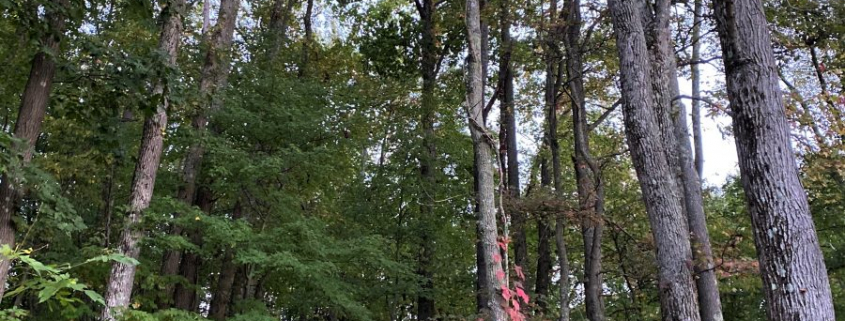Late September Wanderings and Ramblings on my Ohio Land Legacy Project Site
I spent two days in late September 2020 completing field work for my Land Legacy Story on 1,100-acre Dutton Farms in Belmont County, Ohio near Flushing. I issued two previous Posts chronicling this compelling tale of Earth stewardship:
- https://stevejonesgbh.com/2018/05/29/idyllic-pastoral-earth-stewardship-surprise-exemplar/
- https://stevejonesgbh.com/2019/04/19/mid-march-revelations-on-worn-out-land-2/
Here is the very essence of the Dutton Land Legacy Story: abusive agricultural practices from 1850 to 1930 led to debilitating erosion, bankruptcy, and farm abandonment. By mid-twentieth century strip-mining further transformed (some would say destroyed) 85 percent of what is now Dutton Farms. The Dutton’s acquired the property and have systematically reclaimed, rehabilitated, and nurtured the Farm to its current condition as a productive cattle ranch focusing on prime Akaushi cow-calf operation. Theirs is a remarkable tale of adopting and applying a land ethic, treating the land with respect and a view to the distant future.
I intend to demonstrate with photos and text that caring and acting responsibly are necessary elements of meeting our stewardship responsibilities. I’ll begin with the closing observations in my April 2019 Post.
“Louis Bromfield, an Ohio-born novelist and playwright who devoted his life to rehabilitating the soil on his old worn-out farm (Malabar) near Mansfield, summarized a zeal and ethic embraced by the Dutton’s:
The adventure at Malabar is by no means finished… The land came to us out of eternity and when the youngest of us associated with it dies, it will still be here. The best we can hope to do is to leave the mark of our fleeting existence upon it, to die knowing that we have changed a small corner of this earth for the better by wisdom, knowledge and hard work.
I’ll offer broadly and succinctly that embracing and practicing Earth stewardship is reward and fulfillment in and of itself. I discerned four distinct lessons from developing this Post:
- Nature knows disturbance — learn to harness her wisdom.
- Very few things are as they first appear.
- So much in Nature lies hidden within.
- Earth stewardship is a multi-generational commitment of passion and action.”
Bucolic Landscape on a Rehabilitated Strip Mine
The entire viewscape in the three photos below has been strip-mined and subsequently reclaimed. The 120-page final Land Legacy document we are preparing (and will ultimately publish and post on my site) will tell the tale with full text and lots of photographs. My purpose with this Post is to provide a broad overview and hint at the power of an embraced and practiced land ethic. I took these three photos from the Dutton’s east-facing back patio.
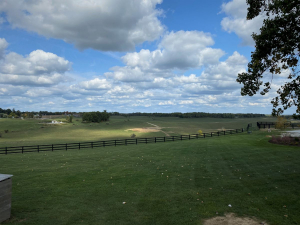
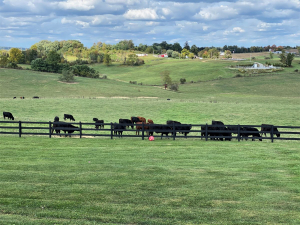
The steeper pasture below (tan, beyond the immediate green fields) is a reclaimed high-wall that sits opposite the cabin where I stayed (see later). Even with my doctoral level education in applied ecology and five decades of experience in the field, with only this photo as evidence, I would not leap to a conclusion that these are photos of a rehabilitated strip-mine!
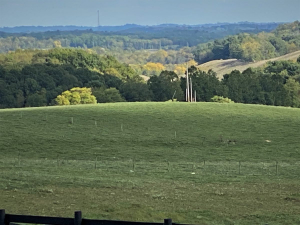
I suppose that is what drew me to work with the Dutton family, Earth steward exemplars, to tell their Land Legacy Story.
Dawn from a Cabin Back-dropped by Forested Mining Spoils
I took most of this Post’s photographs during my most recent September 2020 visit. The dormant hardwood trees below signal a winter snapshot, this one in March 2019. The cabin sits at the base of a fully-forested non-reclaimed debris heap. I’ve stayed three times at the cabin for a total of five nights.
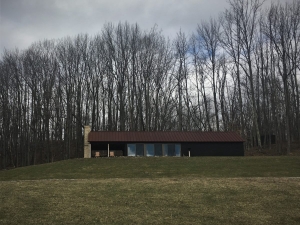
I relish watching night yield to dawn and sunrise, no matter where I am. I captured both dawn (6:50AM; below left) and sunrise (7:26AM) the morning of September 28 from the cabin patio. Again, the entire view-scape is rehabilitated stripped land. Two of the Dutton’s four children shared their respective wedding vows lakeside, each one another kind of new and promising beginning.
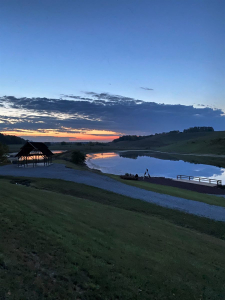
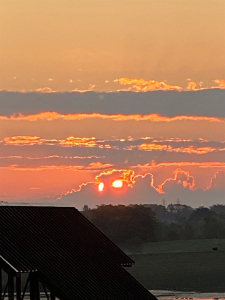
Here’s a view of the hillside across the pond. The rolling pasture is the reshaped 100-foot highwall remaining from the stripping that created the depression that is now the pond. I like the soft light of dawn reflections of hillside vegetation.
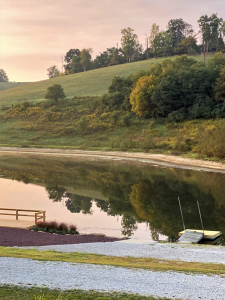
And from the shore, another look at the cabin and its forested debris heap, which seems like such an unpleasant descriptor for a sylvan slope forest that has healed a harsh old scar.
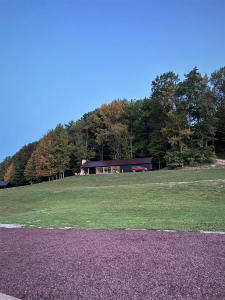
What a labor of love my Dutton Land Legacy work has been. I will always think of the cabin, the land, and the Dutton family as part of my natural soul.
Creating a Nature Trail Demonstrating Successful Reclamation
Since my first visit, Chris Dutton has envisioned an interpretive Nature Trail. He had roughed it out prior to our initial tree identification and tagging in September. I hope to return next May for the Dutton Farms Open House, and hike the completed trail. I’ll give you a preliminary tour now. Below left are two rows of the 60-year-old planted sweetgum (Liquidambar styraciflua) rising parallel up the debris heap. I really do need a more pleasing moniker for the heap — allow me to work on that. Below right Chris is marking a red oak (Quercus rubra) along the trail.
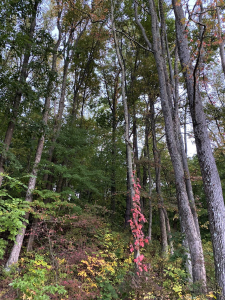
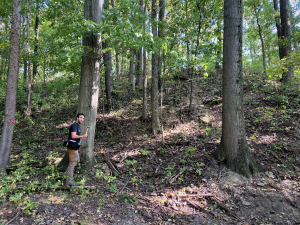
I think I have a better name for the debris heap. The Dutton’s built an off-the-grid hut on the summit. From this day forward I will refer to its location as the Summit Knoll. I think it’s fitting and respectful. The trail winds up the knoll and passes by the hut, where Chris is marking a red maple (Acer rubrum).
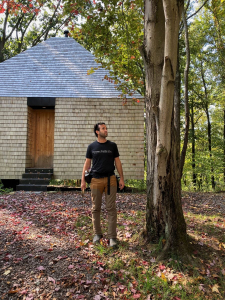
And Chris tagging a white oak (Quercus alba) and below right a white pine (Pinus strobus) along the trail opposite the cabin, which will be accessible via a still-to-be-placed bridge across the head of the marsh feeding into the pond. We believe that the white pine, like the sweetgum, were also planted.
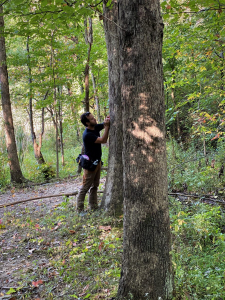
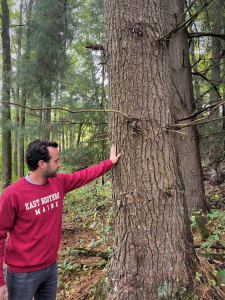
And because I remain impressed with the planted sweetgum standing resolute, remaining tall and healthy, and evidencing excellent survival, I offer one additional photograph as testimony to the tremendous healing power (with dedicated and intentional help from reclamation crews) of Nature. As John Muir so eloquently stated: Nature is always lovely, invincible, glad, whatever is done and suffered by her creatures. All scars she heals, whether in rocks or water or sky or hearts. I am convinced that Nature can heal even the worst of her wounds, whether self-inflicted (e.g., flood, fire, volcano, or earthquake) or at the hand of man.
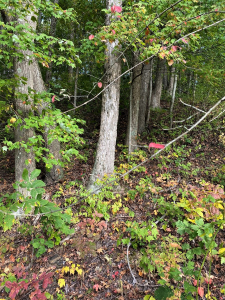
Along the trail we also noted and flagged honey locust (Gleditsia triacanthos) and poison ivy (Toxicodendron radicans).
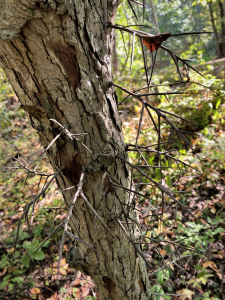
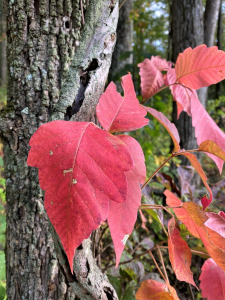
The trail crosses some meadowland atop the knoll. We found abundant milkweed (Asclepias sp.), many of the individuals dispersing their fairy-seeds.
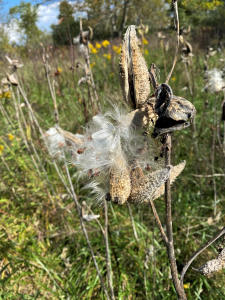
One of the milkweed plants sported a monarch (Danaus plexippus) caterpillar (below left) soon to form its chrysalis for overwintering. Nearby we found a group of large milkweed bug nymphs (Oncopeltus fasciitis) and one adult.
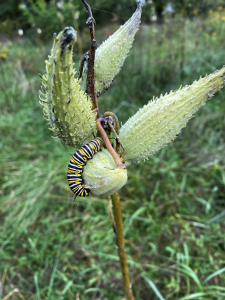
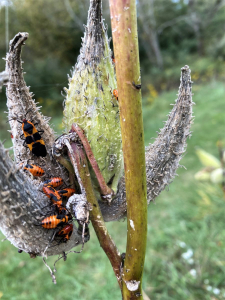
White snakeroot (Ageratina altissima) greeted us with late summer blossoms in the meadow.
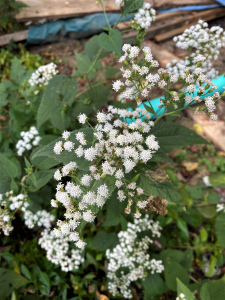
Chicken of the woods (Laetiporus sulphureus) likewise grew atop the knoll. An edible, this fungus had begun to dry and harden, dissuading us from harvesting. Nearby we spotted the largest puffballs I have ever seen. These, too, had matured beyond harvesting, the meat already dark brown. Sixty years allows Nature to progress rapidly along its well-tested healing curve. Again, I repeat the obvious — nothing in Nature is static. Life on our planet has evolved for 3.5 billion years, adapting to strain, change, and perturbation since time immemorial. Nature knows the drill.
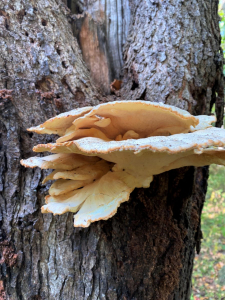
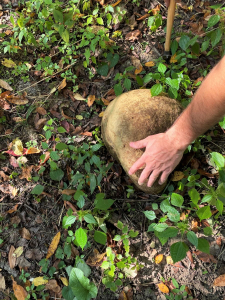
I marvel at Nature’s resilience. Early in my forestry career I would have concluded that strip mining kills the land… destroys Nature’s beauty, magic, wonder, and awe. I know now that Nature is patient, persistent, and well-tooled to handle most disturbances, no matter how harsh and insulting. The Dutton recovery has marked an inflection point in my own growth as a nature enthusiast.
Cattle Operation on Former Wasteland
The Dutton Farms Land Legacy Tale reaches from magnificent natural wealth with the arrival of western settlers, to agricultural abuse and ruin, to abandonment, to decades of strip mining, and now to recovery and return to successful, responsible, commercial agriculture applied and practiced with a deep land ethic. I won’t go into the detail of the commercial cattle operation. I leave that to the final detailed Land Legacy Story. My purpose with these few cattle operation photographs is to provide a feel and flavor for the stewardship practiced to both care for the land and produce income. The Dutton’s are conservationists in the truest sense of the term — practicing wise use and management… sustainably, over many generations… deep into the future. These momma cows are prat of the extensive cow-calf operation.
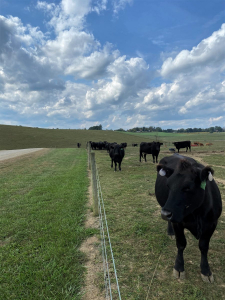
Here are Akaushi purebred bulls. Lest you think I am not fearless and brave, the below right photo shows me photographing one of these ferocious beasts. I could have been charged and trampled had I evidenced any fear whatsoever! Well, perhaps I should mention that these are docile critters, well mannered and quite tolerant of city-cowboys like me.
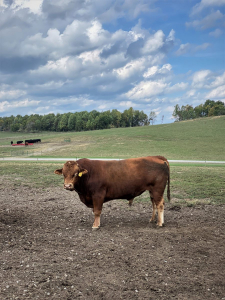
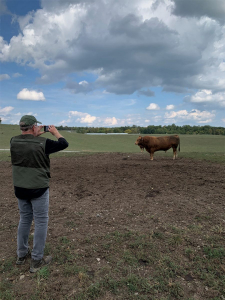
I mentioned in a prior Dutton Post that the cattle operation desperately needed a capable farm manager. Jeff Shepherd came on board in that capacity just weeks after my March 2019 visit. What a pleasure to meet Jeff. This photo speaks volumes: he loves the animals; he knows the art and science of cattle; he understands the technology and the business; he leads the way with absolute purpose, passion, and dedication; he is a consummate land steward; he is an extension of the Dutton’s.
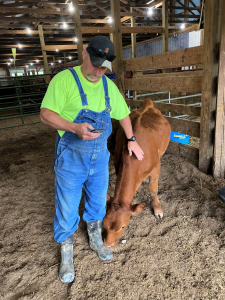
His arrival is a fitting capstone for the current final chapter of this Land Legacy Tale.
Finalizing the Land Legacy Story
I submitted a near-final version of my Land Legacy Tale to the Dutton’s in October. Once finalized and with permission, I will make the entire document available on my website. Theirs is an Earth Stewardship story meriting widespread dissemination. Deep lessons for living, learning, and practicing informed and responsible Earth-care are imbedded. Their commitment is a metaphor for how other individuals, businesses, and society at large can (and must) view and meet our obligation to steward this remote planet we call home. That’s Jeff and me below reviewing the cattle operation.
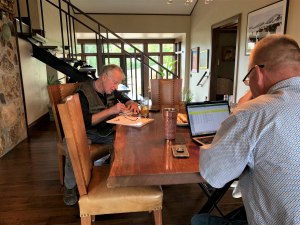
Below left I’m with John Dutton. If only I could absorb osmotically his knowledge of the coal industry, its reach across time, and the specifics of its history on just these 1,100 acres! He has been patient; I have learned a great deal. That’s me below right standing in admiration and reverence for what a difference a land ethic can make in rehabilitating repeatedly abused land… and ensuring its value for all time to come.
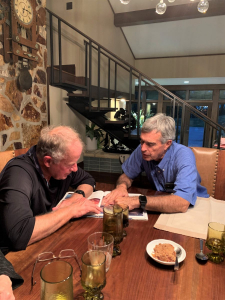

John and Rita Dutton take well-deserved satisfaction (and a moment of relaxation and reflection) in where the land, the family, and the operation now stand. I believe Bromfield’s statement applies to the entire Dutton family: The best we can hope to do is to leave the mark of our fleeting existence upon it, to die knowing that we have changed a small corner of this earth for the better by wisdom, knowledge and hard work. John and Rita have changed a small corner of this earth for the better, and their efforts will continue so long as they (and beyond them, their descendants) reside upon, tend, and love this land.
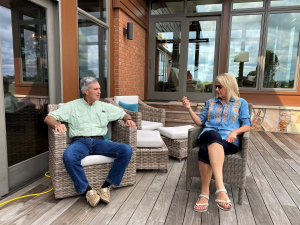
I remain grateful to have engaged in their stewardship quest. I have come to cherish my time with the Dutton family and the land they have rescued from ruin. I hope to visit again, and regularly. Robert Service (Spell of the Yukon) captured the way I feel about the Dutton property:
There’s a land–oh, it beckons and beckons,
And I want to go back–and I will.
As much as the land intrigues and attracts me, more compelling is the story of abuse, stewardship, and recovery. The tale renews my hope that we humans can find the will and the way to more responsibly tend, nurture, and care for this only home we have…this mote of dust in the vast darkness of space. John and Rita exemplify the ethic and practice we must embrace globally.
Thoughts and Reflections
I offer two observations from my September wanderings and ramblings on an amazing tract in Ohio:
- Informed and responsible Earth stewardship actions can rehabilitate even harshly abused land
- Each of us carries the burden to change a small corner of this earth for the better by wisdom, knowledge and hard work
Inhale and absorb Nature’s elixir. May Nature Inspire, Inform, and Reward you!
Note: All blog post images created & photographed by Stephen B. Jones unless otherwise noted. Please circulate images with photo credit: “©2020 Steve Jones, Great Blue Heron LLC. All Rights Reserved.”
Another Note: If you came to this post via a Facebook posting or by an another route, please sign up now (no cost… no obligation) to receive my Blog Post email alerts: http://eepurl.com/cKLJdL
And a Third: I am available for Nature-Inspired Speaking, Writing, and Consulting — contact me at steve.jones.0524@gmail.com
Reminder of my Personal and Professional Purpose, Passion, and Cause
If only more of us viewed our precious environment through the filters I employ. If only my mission and vision could be multiplied untold orders of magnitude:
Mission: Employ writing and speaking to educate, inspire, and enable readers and listeners to understand, appreciate, and enjoy Nature… and accept and practice Earth Stewardship.
Vision:
- People of all ages will pay greater attention to and engage more regularly with Nature… and will accept and practice informed and responsible Earth Stewardship.
- They will see their relationship to our natural world with new eyes… and will understand more clearly their Earth home.
Tagline/Motto: Steve (Great Blue Heron) encourages and seeks a better tomorrow through Nature-Inspired Living!
Steve’s Three Books
I wrote my books Nature Based Leadership (2016), Nature-Inspired Learning and Leading (2017), and Weaned Seals and Snowy Summits: Stories of Passion for Place and Everyday Nature (2019; co-authored with Dr. Jennifer Wilhoit) to encourage all citizens to recognize and appreciate that every lesson for living, learning, serving, and leading is either written indelibly in or is powerfully inspired by Nature.
I began writing books and Posts for several reasons:
- I love hiking and exploring in Nature
- I see images I want to (and do) capture with my trusty iPhone camera
- I enjoy explaining those images — an educator at heart
- I don’t play golf!
- I actually do love writing — it’s the hobby I never needed when my career consumed me
- Judy suggested my writing is in large measure my legacy to our two kids, our five grand kids, and all the unborn generations beyond
- And finally, perhaps my books and Blogs could reach beyond family and touch a few other lives… sow some seeds for the future


All three of my books (Nature Based Leadership; Nature-Inspired Learning and Leading; Weaned Seals and Snowy Summits) present compilations of personal experiences expressing my (and co-author Dr. Wilhoit for Weaned Seals and Snowy Summits) deep passion for Nature. All three books offer observations and reflections on my relationship to the natural world… and the broader implications for society. Order any and all from your local indie bookstore, or find them on IndieBound or other online sources such as Amazon and LifeRich.

